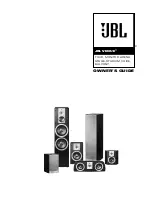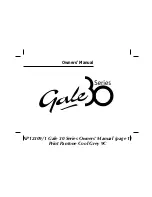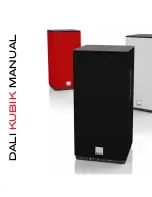
6
Paradigm
®
speakers are efficient and can be driven to loud listening levels
with moderate amplifier power. They are also able to handle the output of
very powerful amplifiers. To prevent damage to your speakers, please read
the following guidelines before hooking them up.
Amplifier Distortion—The #1 Culprit!
Amplifier distortion is the principal cause of speaker damage. When listening
at loud levels your amplifier may run out of clean power. It will then begin to
produce distorted power several times greater than its rated output power.
This will damage any brand of speaker very quickly!
(See your Authorized
Paradigm
®
Dealer for amplifier recommendations.)
More Powerful Amplifiers are Safer
A 40 watt/channel amplifier will have substantial distortion above 40 watts.
If driven to 50 watts, this amplifier will deliver distorted power—which will
damage the speaker! A 100 watt/channel amplifier will have substantial
distortion above 100 watts, but very low distortion below 100 watts. There-
fore, when the speaker requires 50 watts, this more powerful amplifier will
deliver clean power and speaker damage is less likely to occur.
Volume Control
Do not be fooled by the Volume Control of your receiver/preamplifier. It only
adjusts listening level—it is not a “power-output” dial. The amount of
amplifier power actually used at a given Volume Control setting depends
solely on the nature of the music you are listening to. At a given Volume
Control setting a quiet section of music will use less amplifier power than
a loud section. With typical pop-rock, jazz or large scale classical music,
the rated output power of many receivers/amplifiers is often reached when
the Volume Control is between the “11” and “1 o’clock” settings (with bass/
treble and loudness controls not used—otherwise rated power may be
reached at even lower Volume Control settings).
Remember, all amplifiers produce distortion when operated beyond their
rated output power. The resulting distortion will damage all speakers!
Exercise caution! If you listen at loud levels, be careful to listen for the point
of audible distortion—if the speakers begin to sound distressed, turn the
Volume Control down or your speakers and/or amplifier(s) will be damaged!
This type of damage constitutes abuse and is not covered by the
warranty.
If louder volumes are desired, obtain a more powerful amplifier.
There is a Limit!
Although more powerful amplifiers are safer, there is a point at which you
could have more power than the speaker can handle. At that point you will
overpower the speaker and damage it. Exercise caution! At loud levels do
not increase bass/treble controls from zero and ensure that all loudness/
contour/bass EQ buttons are off (otherwise rated output power will be
reached at lower volume control settings). If you listen at loud levels, watch
for excessive visible cone excursion (grille movement) from the woofer—
then turn the Volume Control down.
The Right Amount of Power
A power-range rating is given as a guide to indicate the approximate
minimum and maximum power input of your Paradigm
®
speakers. Amplifiers
that exceed your speaker’s power-range rating are recommended. Their
greater power reserves provide better sound. However, exercise caution!
Use the speakers within their power-range rating to prevent damage (keep
listening levels below the point of excessive woofer cone excursion).
PREVENTING SPEAKER DAMAGE
Break-In
Although Paradigm
®
speakers sound great “out of the carton,” they will
sound even better when broken in. Allow them to operate for several hours
before you listen critically.
High-frequency drivers use ferro-fluid that can thicken at temperatures
below 10° C (50° F). If your speakers have been transported or stored in the
cold let them warm to room temperature before use.
Cleaning
Do not use a strong or abrasive cleaner on your speakers. Clean them with
a damp soft cloth, but do not get them wet. Do not place wet objects, such
as drinking glasses or potted plants, on top of the speakers. If allowed to
soak in, even a small amount of water may permanently damage the
speaker enclosure.
Spikes and Outrigger Feet
Isolation spikes are included with floorstanding models. We highly recommend
installing these spikes as they will improve the sound of your speakers by
isolating them from the floor. The most convenient time to install spikes and
outrigger feet is during the unpacking process (see Fig. 1).
Optional Paradigm
®
Speaker Stands/Wall Mounting
We highly recommend placing bookshelf speakers on high-performance
Paradigm
®
speaker stands
(sold separately), or bookshelves, in order to raise
the high-frequency drivers to approximately ear level, thereby ensuring the
best performance possible.
Pilot holes spaced 60 mm apart are provided on the back of all bookshelf
models for use with wall mounting brackets
(not included), in which case, be
sure to follow the mounting instructions included with the brackets. Always
use brackets rated to support the speakers’ weight. Use #12 screws to attach
brackets to speakers. To prevent damage or personal injury, use safety straps
(not included) as secondary restraints and follow all of the manufacturer’s
mounting instructions.
YOUR NEW SPEAKERS


































